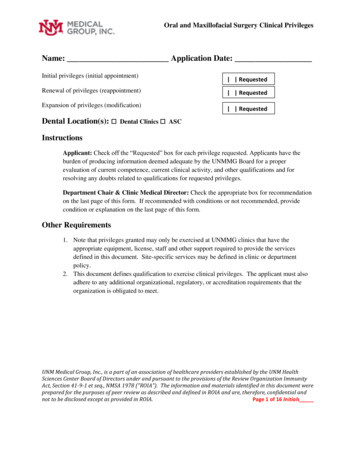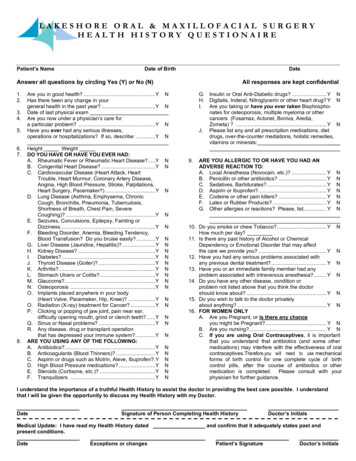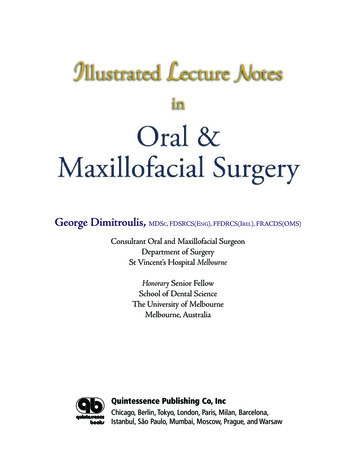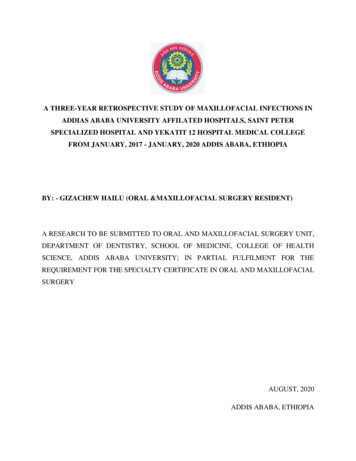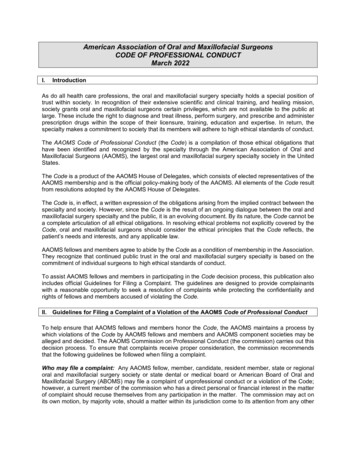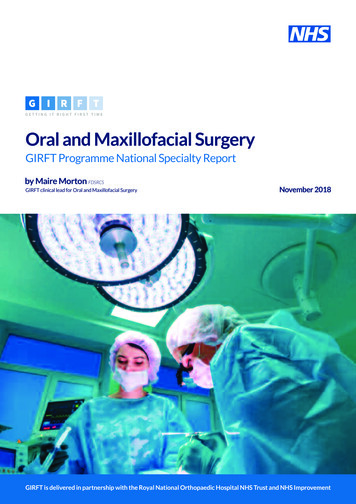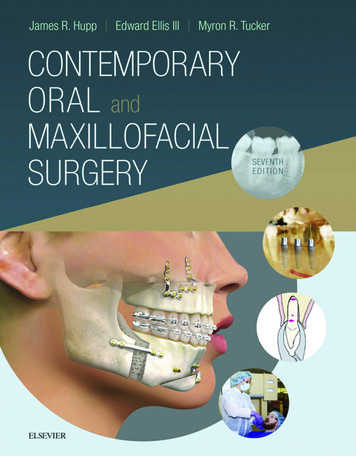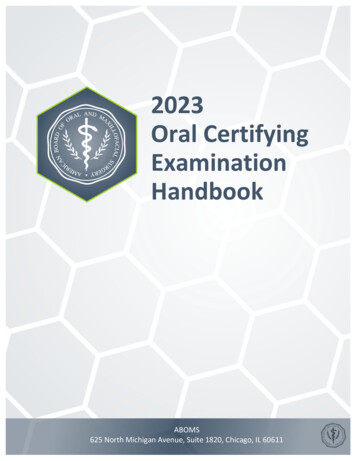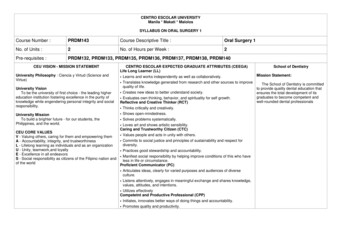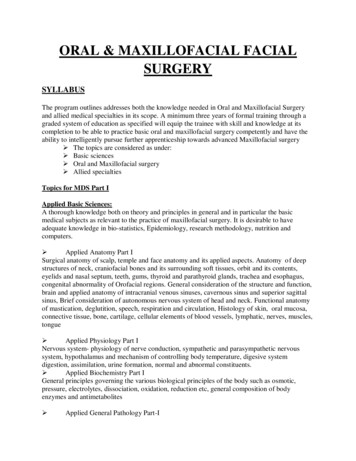
Transcription
ORAL & MAXILLOFACIAL FACIALSURGERYSYLLABUSThe program outlines addresses both the knowledge needed in Oral and Maxillofacial Surgeryand allied medical specialties in its scope. A minimum three years of formal training through agraded system of education as specified will equip the trainee with skill and knowledge at itscompletion to be able to practice basic oral and maxillofacial surgery competently and have theability to intelligently pursue further apprenticeship towards advanced Maxillofacial surgery The topics are considered as under: Basic sciences Oral and Maxillofacial surgery Allied specialtiesTopics for MDS Part IApplied Basic Sciences:A thorough knowledge both on theory and principles in general and in particular the basicmedical subjects as relevant to the practice of maxillofacial surgery. It is desirable to haveadequate knowledge in bio-statistics, Epidemiology, research methodology, nutrition andcomputers. Applied Anatomy Part ISurgical anatomy of scalp, temple and face anatomy and its applied aspects. Anatomy of deepstructures of neck, craniofacial bones and its surrounding soft tissues, orbit and its contents,eyelids and nasal septum, teeth, gums, thyroid and parathyroid glands, trachea and esophagus,congenital abnormality of Orofacial regions. General consideration of the structure and function,brain and applied anatomy of intracranial venous sinuses, cavernous sinus and superior sagittalsinus, Brief consideration of autonomous nervous system of head and neck. Functional anatomyof mastication, deglutition, speech, respiration and circulation, Histology of skin, oral mucosa,connective tissue, bone, cartilage, cellular elements of blood vessels, lymphatic, nerves, muscles,tongue Applied Physiology Part INervous system- physiology of nerve conduction, sympathetic and parasympathetic nervoussystem, hypothalamus and mechanism of controlling body temperature, digesive systemdigestion, assimilation, urine formation, normal and abnormal constituents. Applied Biochemistry Part IGeneral principles governing the various biological principles of the body such as osmotic,pressure, electrolytes, dissociation, oxidation, reduction etc, general composition of bodyenzymes and antimetabolites Applied General Pathology Part-I
Wound management- wound healing factors influencing healing properties of suture materials,appropriate uses of sutures, Hypersensitivity, Shock and pulmonary failure, types of shock,diagnosis, resuscitation, pharmacological support, ARDS and its causes and prevention,ventilation and support. Applied General Microbiology Part ICulture and sensitivity tests, various staining techniques – Smears and cultures, urine analysisand culture Applied Oral Pathology and microbiology Part-IRegressive changes of teeth, bacterial, viral, mycotic infections of oral cavity, dental caries,diseases of pulp and Periaical tissues, wide range of pathological lesions of hard and soft tissuesof the Orofacial regions like the odontogenic infection, maxillary sinus diseases, mucosaldiseases, role of laboratory investigation in oral surgery. Applied Pharmacology and therapeutics Part-IDosage and mode of administration of drugs, action and fate in the body, drug addiction,tolerance and hypersensitive reactions, antiseptics, antitubercular, sialagogues, hematinics,antidiabetic, vitamins A, B complex, C,D,E,K. Applied Computer science Part-IUse of computers in surgery, components of computer and its use in practice, principles of wordprocessing, spreadsheet function, database and presentations, the internet and its use. The valueof computer based systems in biomedical equipment. ORAL AND MAXILLOFACIAL SURGERY. Evolution of Maxillofacial surgery Diagnosis, history taking, clinical examination, investigations Informed consent/medico-legal issues. Concept of essential drugs and rational use of drugs Principles of surgery- developing a surgical diagnosis, basic necessities for surgeryaseptic techniques, incisions, flap designs, tissue handling, hemostasis, dead spacemanagement, decontamination and debridement, suturing, edema control, patientgeneral health and nutrition. Pre operative workup – Concept of fitness for surgery, basic medical work up: workup in special situation like diabetes, renal failure, cardiac and respiratory illness, riskstratification Surgical sutures, drains Post operative care concept of recovery room care, Airway management, Assessmentof Wakefulness, management of cardiovascular instability in this period, Criteria forshifting to the word, pain management.
Topics for MDS Part II ORAL AND MAXILLOFACIAL SURGERY Communication skills with patients – Understanding clarify in communication,compassionate explanations and giving emotional support at the time of sufferingand bereavementPrinciples of evidence based surgery- understanding journal based literaturestudy, the value of textbook, reference book articles, value of review articles,original articles and their critical assessment, understanding the value ofretrospective, prospective, randomized control and blinded studies, understandingthe principles and the meaning of various Bio-statistical tests applied in thesestudies.Medical emergencies – Prevention and management of altered consciousness,hypersensitivity reaction, chest discomfort, respiratory difficulty.Wound management- Wound healing, factors influencing healing, basic surgicaltechniques, Properties of suture materials, appropriate use of sutures.Surgical infections- Asepsis and antisepsis, Microbiological principles, Rationaluse of antibiotics, infections like Synergistic Gangrene and Diabetic footinfection, Hepatitis and HIV infection and cross infection.Airway obstruction management – Anatomy of the airway, principles of keepingthe airway patent, mouth resuscitation, Oropharyngeal airway, endotrachealintubation, Cricothyroidectomy, TracheotomyFacial pain – Facial palsy and nerve injuriesPain control – acute and chronic pain, cancer and non-cancer pain, patientcontrolled analgesiaGeneral patient management- competence in physical assessment of patients forsurgery, competence in evaluation of patients presenting with acute injury,particularly to maxillofacial region. Competence in the evaluation of managementof patients for Anesthesia.Clinical oral surgery- all aspects of dento-alveolar surgeryPre-prosthetic surgery- A wide range of surgical reconstructive proceduresinvolving the hard and soft tissues of the edentulous jawsTemporomandibular joint disorders – TMJ disorders and their sequelae needexpert evaluation, assessment and management. It is preferable to be familiar withdiagnostic and therapeutic arthroscopic surgery procedures.Cyst and tumors of head and neck region and their management- includingprinciples of tumor surgery, giant cell lesion of jaw bones, fibro-osseous lesion ofjawsNeurological disorders of maxillofacial region- diagnosis and management ofTrigeminal Neuralgia, MPDS, Bells palsy, Frey’s syndrome, Nerve injuriesMaxillofacial trauma – basic principles of treatment, primary care diagnosis andmanagement of hard and soft tissue injuries, Comprehensive managementincluding polytrauma patients
Assessment of trauma-multiple injuries, patients with closed abdominal and chestinjuries or penetrating injuries, pelvic fractures, urological injuries, vascularinjuries Distraction osteogenesis in maxillofacial region Implantology principles- surgical procedures for insertion of various types ofimplantsAllied specialties Neuro-surgery: Evaluation of a patient with head injury, examination of variousNeurosurgical procedures. ENT/ Ophthalmology: Examination of ear, nose throat, exposure to ENT surgicalprocedures, ophthalmic examination and evaluation, exposure to ophthalmicsurgical procedures. Orthopaedic: Basic principles of Orthopaedic surgery, bone diseases and traumaas relevant to Maxillofacial surgery, interpretation of radiographs, CT, MRI andUltrasound.Topics for MDS Part III ORAL & MAXILLOFACIAL SURGERY Principles of surgical audit – understanding the audit of process and outcome.Methods adopted for the same, basic statistics. Tissue grafting – understanding of the biological mechanisms involved inautogenous and heterogenous tissue grafting. Reconstructive oral andmaxillofacial surgery- hard tissue and soft tissue reconstruction. Laser surgery – The application of laser technology in the surgical treatment oflesions amenable to such therapy. Cleft lip and palate surgery – detail knowledge of the development of the face,head and neck, diagnosis and treatment planning, current concepts in themanagement of cleft lip and palate deformity, knowledge of nasal endoscopy andother diagnostic techniques in the evaluation of speech and hearing, concept ofmulti disciplinary team management. Aesthetic facial surgery – detailed knowledge of structures of facial neckincluding skin and underlying soft tissues, diagnosis and treatment planning ofdeformities and conditions affecting facial skin, underlying facial muscles, bone,eyelids, external ear etc. Surgical management of post acne scaring, face lift;blepharoplasty, facial bone recontouring etc. Craniofacial surgery- basic concept of developmental anomalies of face, head andneck, basics concepts in the diagnosis and planning of various head and neckanomalies including facial cleft, craniosynostosis syndromes etc. Current conceptsin the management of craniofacial anomalies. Head and Neck Oncology: understanding of the principles of management of headand neck oncology including various pre-cancerous lesions. Experience in thesurgical techniques of reconstruction following ablative surgery. Micro vascular surgery
SUGGESTED BOOKS1. Text book of Oral & Maxillofacial Surgery – Laskin Vol. 1 & 22. Principles of Oral & Maxillofacial Surgery – Peterson Vol. 1 & 23. Maxillofacial Injuries – Row & Williams Vol.1 & 24. Maxillofacial Trauma Fonseca Vol. 1 &25. Maxillofacial Infections – Topazian6. Text book of Oral & Maxillofacial Surgery – Peter Ward booth Vol.1 & 27. Maxillofacial Trauma & reconstruction- Peter Ward booth8. Plastic Surgery- Mathes Vol. 1 to 59. Oral Oncology – J.P.Jain10. Oral Cancer- McGregor11. Minor Oral Surgery – G.L. Howe12. Extraction of teeth- G.I.Howe13. Text book of Oral & Maxillofacial Surgery – Fonseca Vol. 1 to 714. Text book of Preprosthetic Surgery – Starshack15. Dentofacial deformities – Bell Vol.1 & 316. Facial esthetics & Dentofacial deformities – Epker Vol 1 to 417. Principles of Oral & Maxillofacial Surgery – Moore18. Complications of Oral & Maxillofacial Surgery – Kaban19. Current advances in Oral & Maxillofacial Surgery – Irby & Shellon20. Controversies in Oral & Maxillofacial Surgery21. Operative Maxillofacial Surgery – Langdon & Patel22. Local anesthesia – Malamed23. Bennett’s text book of local anesthesia – Monheims24. Text book of local analgesia – Roberts25. Distraction Osteogenesis – Sanchukov26. Distraction Osteogenesis- McCarthySUGGESTED PERIODICALS1. Journal of Oral & Maxillofacial Surgery2. British Journal of Oral & Maxillofacial Surgery3. International Journal of Oral & Maxillofacial Surgery4. Oral medicine, Oral surgery, Oral pathology, Oral Radiology & Endodontics5. Journal of Craniofacial surgery6. Journal of Cranio Maxillofacial Surgery7. Oral & Maxillofacial Surgery clinics of North America8. Atlas of Oral & Maxillofacial Clinics of North America9. Plastic & Reconstructive Surgery10. Oral Oncology11. British Dental Journal12. Journal of American Dental Association13. Australian Dental Journal14. Journal of Canadian Dental Association
Academic Clinical programme (applicable for all three years) Seminars to be presented and attended once in a week Journal clubs (departmental and interdepartmental) to be conducted once in fifteen days Every candidate shall maintain a logbook to record his/hers work of participation in allactivities such as journal clubs, seminars, CDE programs etc. this work shall bescrutinized and certified by the head of the departmental and head of the institution andpresented to the university every year.Year by year programme1 yearFirst termDissection, basic sciences, basic computer sciences, exodontia, seminars on basic topics,selection of dissertation topic, library assignment topic, attending O.T and ward rounds,preparation of synopsis and its submission within six months after admission to the university asper calendar of eventsSecond term (rotation and postings in other department)Emergency – on rotation basis 1 monthGeneral medicine – 2 monthsGeneral surgery – 2 monthsAnaesthesia - 1 monthExamination of basic sciences – one paper of three hours duration to be conducted by thecollege/universityII yearMinor oral surgery and higher surgical trainingSubmission of library assignment by the end of first termRotation and postings in other departmentOncology – 2 monthsOpthalmology – 15 daysNeurology – 1 monthENT – 1 monthOrthopaedic – 1 monthRadiology – 15 daysPlastic surgery – 1 monthEmergency – on rotation basis 2 monthsExamination on minor oral surgical procedures – one paper of three hours duration to beconducted by the college.
III yearEmergency – on rotation basis 2 monthsMaxillofacial surgery, submission of dissertation in the first term, i.e. six months before the finalexamination to the universityExamination of three hours duration three months before the final examination to be conductedby the college. It is desirable to enter general surgical skills and operative procedures that areobserved, assisted or performed in the log book.Final examination at the end of the third yearSl.No Procedure1Injection I.M. and I.V2Minor suturing and removalof sutures3Incision & drainage of anabscess4Surgical extractionImpacted teethPre prosthetic surgerya.Correctiveproceduresb.Ridge extensionc.Ridge reconstructionOaf ClosureCyst enuleationMandibular fracturesPeri-apical surgeryInfection managementBiopsy proceduresRemoval of salivary calculiBenign tumorsMid face fracturesImplantsTracheotomySkin graftsOrthognathic surgeryHarvesting bone & cartilageGraftsa.Ililac crestb.Ribc.Calvariald.FibulaCategoryP1P1YearI, IIINumber50,20NAP1I10P1P1, PA1I1550,20P1PAAII, IIIi, iii1533P1, PAP1, PAP1, PAP1, PAP1, PAP1PAPA, APA, APA, APA,APAPA, AI, III, III, IIII, III, III, IIII, IIIII, IIIII, IIIII, IIIII, IIIII, IIIII322
T.M. Joint surgeryJaw resectionsOnco surgeryMicro vascular anastomosisCleft lip & palateDistraction osteogenesisRhinoplastyAccess osteotomies and baseof skull surgeriesPA,APA, AA, OA, OPA, AA.OA,OA,OII, IIIII, IIIII, IIIIIIIIIIIIIIIIIIFORMATIVE EVALUATION PATTERNMDS Part ITheory and Practical Exam every 6 months.Theory – Paper I & IIPortion- Applied Basic Sciences and Minor Oral SurgeryPractical – Performing ExodontiaMDS Part IITheory and Practical Exam every 6 months.Theory – Paper I - IVPortion- Complete Portion except Supramajor Oral Maxillofacial SurgeryPractical – Performing surgical removal of third molar.MDS Part IIITheory and Practical Exam every 6 months.Theory – Paper I - IVPortion- Complete PortionPractical – Performing surgical removal of third molar.Apart from the above, every student is evaluated on day to day basis based on –1. Treatment on out patient & in patient basis2. Seminar presentations4. Journal club presentations13,33,35,1010,152,33,51,3
5. Case presentation6. Theory Exam – Part I - Every 3 months, Part II - Every 2 months, Part III - Every monthYEAR WISE DUTIES OF PG”sFIRST YEARIn addition to the duties as per curriculum proposed by DCI / Dr. Ram Manohar Lohia Awadh University,1st year P.G’s posted in U.G. clinic are also responsible for the following:1.Conducting the undergraduate students if some assistance is required by them in undergraduateclinic.2.Helping the undergraduate students if some assistance is required by them in exodontias and otherminor surgical procedures.3.Recording complete history, getting the investigations (including biopsy) done and making thediagnosis of patients for the minor (impaction, apicoectomy etc) as well as major surgical cases coming tothe department.4.Minor cases thus selected and worked, on by 1st year P.G’s will be handed over to 2nd year P.G.and the same 1st year P.G will assist the senior PG in conducting the minor surgery the next day.5.Ensuring the cleanness, sterilization & fumigation of PG section. He /She will also assist thesenior PG in conducting minor surgeries in PG clinics.6.Ensuring that all the electric / electronic gadget in the department are switched of at the of theworking day.7.To attend ward round twice daily.8.Any other work assigned to them by the HODIn performing all duties mentioned above, 1st year P.G students will be closely observed by the seniorlecturers and other seniors M.D.S. staff posted in respective sections of the department.SECOND YEAR2nd year P.G. students are supposed to conduct the minor surgeries allotted to them by the HOD underclose supervision of a teaching staff. Each step of the surgical procedure performed shall be observed andevaluated by the supervision MDs staff and record should be maintained and submitted to the HOD forthe final approval.In addition to the duties as per curriculum proposed DCI/Dr. Ram Manohar Lohiya Awadh University,2nd year P.G posted is also responsible for the following:1.Helping & guiding the 1st year students in performing their above mentioned duties.
2.Pre anesthetic evaluation and preparation of the patients for minor / major surgery under G.A /L.A in operation theatre.3.Keeping (along with 3rd year students) the material, instruments, medicines and medicamentready for use on the patient before during and after the surgery.4.After complete evaluation and discussion with the teaching staff, performing the minor surgicalprocedures on patients selected by the 1st year P.G Student for him / Her. These minor surgeries are to beperformed strictly under close supervision of teaching staff.5.Attending to the case coming in the saraswati hospital and research center on the designated dateof emergency duty. In case they fill the case cannot be handled by them a request to the consultant on callshould be made immediately without wasting time.6.Presurgical preparation of the patient and shifting the patient to OT in time after taking the recentconcent of patient / gauardian for sugery / Anesthesia. The surgical and anesthetic risks involved shouldbe explained to the patient in detailed in writing.7.Proper documentation of the pre, Intra , Post surgical & follow up record ( Photograph,Radiographs, cast models and investigation record etc.) Record should be submitted within a week afterpatient is discharged. Records of the follow up of the patient should be maintained carefully andcompletely as per the treatment plane. Counter signatures of the teaching staff is must on all the records.8.Post operative care of the patients under of faculty.9.To arrange and attend ward round twice daily.10.Any other duties assigned to them by HODTHIRD YEARIn addition to the duties as per curriculum proposed DCI/Dr. Ram Manohar Lohiya Awadh University,3rd year P.G posted is also responsible for following : 1.All cases posted for surgery should be presented by them at least a day prior to the OT day.2.Attending to the casualties coming in the Saraswati Hospital & Research Centre on the designateddate of the emergency duty. In case they feel the case cannot be handled by them a request to theconsultant on call should be made immediately without wasting time.3.After complete evaluation and discussion with the teaching staff, performing the minor surgicalprocedures on patients selected by the 1st year P.G student for him/her. These minor surgeries are to beperformed strictly under close supervision of the teaching staff.4.3rd year students are responsible for the total preoperative preparation and postoperativemanagement of the major cases. They may take the help of 1st and 2nd year PG student.5.They have to arrange (along with 2nd Year P.G student) the materials, instruments, medicinesand medicaments ready for the use on the patient before, during and after the surgery.
6.Presurgical preparation of the patient and shifting the patient to OT in time after taking thewritten consent of the patient/guardian for surgery/ anaesthesia. The surgical and anesthetic risks involvedshould be explained to the patient in detail in writing.7.Proper documentation of the pre,intra, post surgical and follow-up records (photographs,radiographs, cast models and investigation records etc.)8.To arrange/ attend morning and evening ward round daily.9.Any other duty assigned to them by HODSUMMATIVE EVALUATION PATTERNScheme of MDS Examination:(A) Theory ExaminationThere shall be four paper for the examination. Each paper shall be of three hours duration. Patternof question paper is as follows:For Paper I to IIISr.No.Nature of questionDivision of marksTotal marks1.Long Answer Question2 x 20402.6 out of 7 short Answer Questions6 x 1060Total Marks100For Paper IVSr. No.Nature of questionDivision of marksTotal marks1.Essay (1 out of 2 )1 x 100100(B) Practical/Clinical Examination300 Marks.1. Minor Oral Surgery ( Surgical Removal of Mandibular third molar)1502. Long Case Discussion1003. Short Case Discussion50Total300 Marks
Number of days for conduct of practical examination upto 6 student shall be 2 days. In case thestudent are more than 6, it may exceed to the 3rd day in concurrence with the University.Examination will be conducted by 4 examiners – 2 internal and 2 external examiners.(C ) Viva voce ExaminationGrand Viva - 80Pedogogue- 20100 Marks
17. Principles of Oral & Maxillofacial Surgery - Moore 18. Complications of Oral & Maxillofacial Surgery - Kaban 19. Current advances in Oral & Maxillofacial Surgery - Irby & Shellon 20. Controversies in Oral & Maxillofacial Surgery 21. Operative Maxillofacial Surgery - Langdon & Patel 22. Local anesthesia - Malamed 23.
